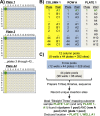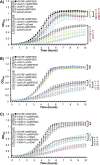Comprehensive Functional Analysis of the Enterococcus faecalis Core Genome Using an Ordered, Sequence-Defined Collection of Insertional Mutations in Strain OG1RF
- PMID: 30225373
- PMCID: PMC6134198
- DOI: 10.1128/mSystems.00062-18
Comprehensive Functional Analysis of the Enterococcus faecalis Core Genome Using an Ordered, Sequence-Defined Collection of Insertional Mutations in Strain OG1RF
Abstract
Enterococcus faecalis is a common commensal bacterium in animal gastrointestinal (GI) tracts and a leading cause of opportunistic infections of humans in the modern health care setting. E. faecalis OG1RF is a plasmid-free strain that contains few mobile elements yet retains the robust survival characteristics, intrinsic antibiotic resistance, and virulence traits characteristic of most E. faecalis genotypes. To facilitate interrogation of the core enterococcal genetic determinants for competitive fitness in the GI tract, biofilm formation, intrinsic antimicrobial resistance, and survival in the environment, we generated an arrayed, sequence-defined set of chromosomal transposon insertions in OG1RF. We used an orthogonal pooling strategy in conjunction with Illumina sequencing to identify a set of mutants with unique, single Himar-based transposon insertions. The mutants contained insertions in 1,926 of 2,651 (72.6%) annotated open reading frames and in the majority of hypothetical protein-encoding genes and intergenic regions greater than 100 bp in length, which could encode small RNAs. As proof of principle of the usefulness of this arrayed transposon library, we created a minimal input pool containing 6,829 mutants chosen for maximal genomic coverage and used an approach that we term SMarT (sequence-defined mariner technology) transposon sequencing (TnSeq) to identify numerous genetic determinants of bile resistance in E. faecalis OG1RF. These included several genes previously associated with bile acid resistance as well as new loci. Our arrayed library allows functional screening of a large percentage of the genome with a relatively small number of mutants, reducing potential effects of bottlenecking, and enables immediate recovery of mutants following competitions. IMPORTANCE The robust ability of Enterococcus faecalis to survive outside the host and to spread via oral-fecal transmission and its high degree of intrinsic and acquired antimicrobial resistance all complicate the treatment of hospital-acquired enterococcal infections. The conserved E. faecalis core genome serves as an important genetic scaffold for evolution of this bacterium in the modern health care setting and also provides interesting vaccine and drug targets. We used an innovative pooling/sequencing strategy to map a large collection of arrayed transposon insertions in E. faecalis OG1RF and generated an arrayed library of defined mutants covering approximately 70% of the OG1RF genome. Then, we performed high-throughput transposon sequencing experiments using this library to determine core genomic determinants of bile resistance in OG1RF. This collection is a valuable resource for comprehensive, functional enterococcal genomics using both traditional and high-throughput approaches and enables immediate recovery of mutants of interest.
Keywords: TnSeq; functional genomics; gut fitness; opportunistic pathogen.
Figures






References
-
- Agudelo Higuita NI, Huycke MM. 2014. Enterococcal disease, epidemiology, and implications for treatment In Gilmore MS, Clewell DB, Ike Y, Shankar N (ed), Enterococci: from commensals to leading causes of drug resistant infection. Massachusetts Eye and Ear Infirmary, Boston, MA.
-
- Bourgogne A, Garsin DA, Qin X, Singh KV, Sillanpaa J, Yerrapragada S, Ding Y, Dugan-Rocha S, Buhay C, Shen H, Chen G, Williams G, Muzny D, Maadani A, Fox KA, Gioia J, Chen L, Shang Y, Arias CA, Nallapareddy SR, Zhao M, Prakash VP, Chowdhury S, Jiang H, Gibbs RA, Murray BE, Highlander SK, Weinstock GM. 2008. Large scale variation in Enterococcus faecalis illustrated by the genome analysis of strain OG1RF. Genome Biol 9:R110. doi:10.1186/gb-2008-9-7-r110. - DOI - PMC - PubMed
Grants and funding
LinkOut - more resources
Full Text Sources
Other Literature Sources
Molecular Biology Databases
Research Materials

